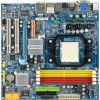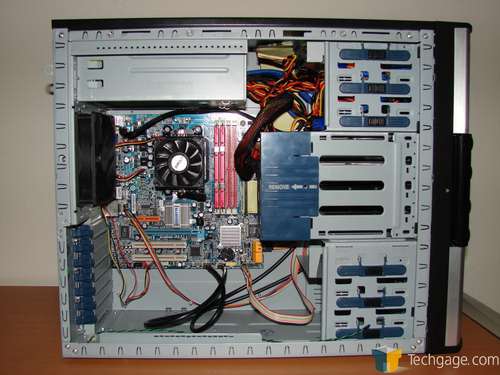- Qualcomm Launches Snapdragon 4 Gen 2 Mobile Platform
- AMD Launches Ryzen PRO 7000 Series Mobile & Desktop Platform
- Intel Launches Sleek Single-Slot Arc Pro A60 Workstation Graphics Card
- NVIDIA Announces Latest Ada Lovelace Additions: GeForce RTX 4060 Ti & RTX 4060
- Maxon Redshift With AMD Radeon GPU Rendering Support Now Available
Gigabyte GA-MA69GM-S2H

Gigabyte’s new GA-MA69GM-S2H board has HTPC written all over it, with no fewer than six possible video output types, optical Toslink output, and AMD’s 690G chipset with Radeon X1250 IGP. In our review, we find more than a few reasons to recommend it to anyone who’s considering a new HTPC.
Page 5 – Testing Methodology, Sandra, PCMark05
The big news here is the Gigabyte GA-MA69GM-S2H’s use of the AMD 690G chipset, which is still a relatively new contender in the IGP arena. It was originally conceived to go toe-to-toe with the reigning champion of the IGPs, the NVIDIA nForce430 chipset with integrated GeForce 6150 graphics core. In our testing, we decided it was appropriate then to do a direct comparison between the GA-MA69GM-S2H and a GeForce 6150-based board from another premier motherboard manufacturer, ASUS (specifically the M2NPV-VM).
All testing here was performed using the same CPU and memory, and a fresh install of Microsoft Windows for each board from a disk image of a clean and working Windows install that had the benchmarking tools pre-installed, but no other non-generic drivers of any sort. During testing, all unnecessary applications and background processes were stopped or closed, and the machine was disconnected from the LAN.
-
Test Platform, HTPC/Low Power v1.0 (rev. 04/07)
- CPU: AMD Athlon 64 X2 4200+ EE (2.2GHz, 65W)
- Memory: A-Data Vitesta DDR2-1000 @ DDR2-800 (4-4-4-12), 1GB (2x 512MB)
- Video: (Onboard IGP)
- HDD: Western Digital 160GB, 7200RPM, 8MB Cache, SATA2 3.0GB/s
- Case: Cooler Master iTower 930
- PSU: OCZ Technology StealthXStream 600W
The memory bandwidth test of SiSoftware’s Sandra XI 2007.SP3 benchmarking suite was used in testing the memory performance of both motherboards. The 2008 version of Sandra became available while this article was being prepared, though we had already produced the first set of benchmark results using Sandra XI 2007. A cursory check revealed virtually no differences in the results delivered by the old version and the new version, so we stuck with Sandra XI 2007.SP3 for this article. Future articles will use the new version of Sandra, however.
Memory Bandwidth
This test evaluates the memory throughput offered by both motherboards. The IGPs of both boards each claim a small share of the system memory for their frame buffer, so the relative efficiency of HyperMemory as compared to NVIDIA’s TurboCache technology may have some effect on the overall results here. Three trials were run here, and the results were averaged to yield the final number.
|
Motherboard
|
Integer (MB/s)
|
FP (MB/s)
|
| Gigabyte GA-MA69GM-S2H | 6182 | 6131 |
| ASUS M2NPV-VM | 4864 | 4821 |
From the outset, it’s clear that the 690G chipset has a real leg up when it comes to memory bandwidth. We tried everything we could to give the GeForce 6150-based board a boost, but in the end the Gigabyte 690G-based board consistently won out. This is one performance parameter that will have a real effect on the board’s performance in other applications.
PCMark2005 is a widely-used and respected synthetic benchmark that tests performance in a wide variety of tasks, from video encoding to physics calculations. It’s also a favorite of the Techgage staff because of its flexibility. Here, we’re using it to test the overall system performance as well as the performance of the memory subsystem.
Overall Score
The PCMark2005 overall score is based on a suite of 11 tests that simulate various types of system usage and stress all the major subsystems of the PC, including the CPU, memory, and graphics systems. This suite also contains multi-threading tests and simultaneous multiple-subsystem stress tests. The score generated can be compared directly with any other machine.
|
Motherboard
|
Score
|
| Gigabyte GA-MA69GM-S2H | 3752 |
| ASUS M2NPV-VM | 3580 |
Here we see that the 690G-based GA-MA69GM-S2H outpaces the M2NPV-VM board by about 5%. This is a small margin, likely due to the GeForce 6150-based board’s lower memory bandwidth coming back to haunt it.
CPU Score
This score is calculated based on only those system tests that stress the CPU. The significance of this test in the context of a motherboard review is to prove that differences in overall performance are not due differences in the amount of CPU overhead during the testing of each board. As you might imagine, the results of this test are primarily CPU-dependent.
|
Motherboard
|
Score
|
| Gigabyte GA-MA69GM-S2H | 4513 |
| ASUS M2NPV-VM | 4511 |
The results here are sufficiently close (less than 0.04%), so it’s reasonable to conclude that what we’re measuring here are true honest-to-goodness performance variations. This is more of a data validation test than anything else.
RAM Score
This score is calculated from tests that stress the memory subsystem. We already have an idea of what to expect, based on the performance difference we saw in the Sandra XI memory bandwidth test.
|
Motherboard
|
Score
|
| Gigabyte GA-MA69GM-S2H | 4012 |
| ASUS M2NPV-VM | 3717 |
As predicted, the GeForce 6150-based board is outperformed by the 690G-based board. What we see here is a definite superiority of the 690G chipset’s memory performance, which translates into improved performance in most applications that aren’t exclusively CPU dependent.
|
|
Support our efforts! With ad revenue at an all-time low for written websites, we're relying more than ever on reader support to help us continue putting so much effort into this type of content. You can support us by becoming a Patron, or by using our Amazon shopping affiliate links listed through our articles. Thanks for your support!





